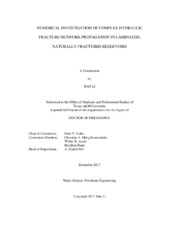| dc.description.abstract | Horizontal wells with multistage hydraulic fractures (HFs) are required for maximizing the oil and gas production from unconventional reservoirs. Since the characterization of complex fracture geometry with high accuracy is still challenging by fracture diagnostic techniques such as microseismic event interpretation, modeling approaches of complex hydraulic fracture propagation become powerful tools for predicting complex fracture geometry and optimizing hydrocarbon production.
In this research, a novel two–dimensional (2D) finite–discrete element model (FDEM) was developed to describe complex fracture propagation in unconventional formations. This coupled fluid flow and geomechanics model can also be applied for multi–fracture, multi–well scenarios. Key physical processes for complex hydraulic fracture propagation in unconventional reservoirs, including hydraulic fracture–natural fracture (NF) interaction, stress shadow effect, hydraulic fracture–bedding plane (BP) interaction, fluid flow in fracture network, leak–off from fracture network, mechanical anisotropy of formations, etc., were successfully incorporated into the model.
The numerical model was utilized to investigate physical mechanisms of complex fracture propagation and offers insights for optimizing hydraulic fracturing treatments design. For multi–fracture propagation scenarios, stress shadow effect induced by opening fractures can affect the propagation direction of fractures, and non–planar fracture geometry may emerge resulting from the effect.
NFs play an important role during the evolution of fracture network geometry. With the increase of initial horizontal stress difference and the angle of NFs, the fracture tends to cross the NFs instead of opening them. For cases with small horizontal stress difference, when there is only one set of NFs with narrow range of strike orientation in the formation, fractures tend to propagate along the strike orientation of NFs. However, for cases with more than one set of NFs, the course of events is more difficult to predict.
Laminated bedding in shale formations typically result in anisotropic elastic properties, including Young’s modulus and the Poisson’s ratio. This fact highly influences the hydraulic fracturing treatment execution. The lamina can confine the hydraulic fracture height, but sometimes they can act as potential fracture propagation paths. Our simulation results show that without considering the mechanical anisotropy effect, the treatment design will be corrupted by the inaccurate prediction of fracture height. Different BP properties, including strength, dip angle, permeability–thickness, etc., also have strong influence on the predicted fracture height.
We also consider fracture height growth in multi–fracture schemes, when the stress shadow effects give rise to non–planar vertical growth and possible fracture branching. The simulations show that hydraulic fracture height growth is substantially restricted in laminated formations.
This work provides a framework for more realistic prediction of complex fracture geometry in unconventional formations that are laminated and naturally fractured. The results offer comprehensive insights for optimizing hydraulic fracturing treatment design | en |


